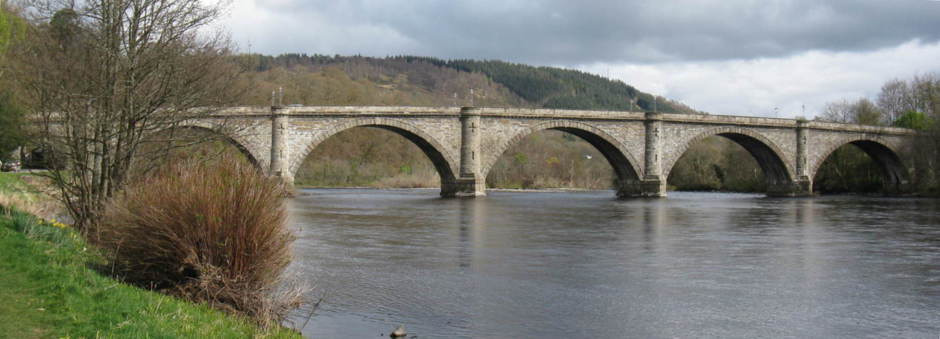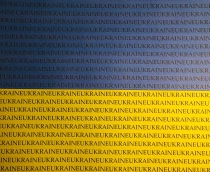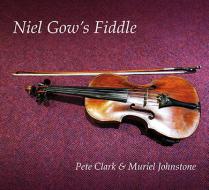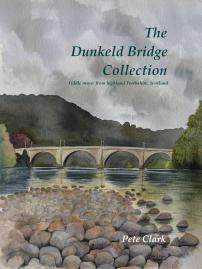"Niel Gow's Fiddle"
Pete Clark & Muriel Johnstone
1. Tullochgorum (Trad.) + Poem
“To Mr Gow Visiting Dumfries” (Burns) 2’55
2. Loch Errochside (Niel Gow & his second wife) /
The Earl of Morton’s Jig (Wm. Gow) /
Miss Stewart of Grandtully Strathspey & Reel (Niel Gow) 4’57
3. Coilsfield House (Nathaniel Gow) 3’11
4. The Duchess of Atholl (Niel Gow) 1’38
5. Farewell to Whisky / Welcome Whisky Back Again / Highland Whisky (Niel Gow) 3’27
6. Mrs Macdougall-Grant (Nathaniel Gow) / Mrs Donaldson (Niel Gow) / Orchill Graham (Niel Gow) 4’05
7. Sir George Clerk of Pennicuik (Nathaniel Gow) / Lady Charlotte Campbell (Nathaniel Gow) / Lady Charlotte Campbell (Robert Mackintosh) 4’23
8. Watson’s Class (Niel Gow) 2’23
9. Major Graham of Inchbrakie (Niel Gow) 2’21
10. Miss Graham of Inchbrakie (Nathaniel Gow) / Lament for James Moray of Abercairney (Niel Gow) 4’41
11. Lady Cunningham of Livingstone (Nathaniel Gow) 1’23
12. Lament of Flora MacDonald (Neil Gow Jnr) 3’11
13. General Lord Glenlyon’s March & Quickstep (John Crerar) 3’12
14. Banks of Garry / The Big Boat of Inver / The Merry Lads of Inver / Inver Lasses (John Crerar) 3’07
15. Nathaniel Gow’s Lament for His Brother (Nathaniel Gow) 2’01
16. Dungarthill / Jamie Wood / Birkenburn (James Macintosh) 3’25
17. Niel Gow’s Lament for the Death of His Brother Donald
(Niel Gow) 2’02
18. Niel Gow’s Lament for the Death of His Second Wife
(Niel Gow) 4’19
“Caught & Released”
Pete Clark & Gregor Lowrey
The Tracks:
Marnoch’s: A strathspey and three reels – Marnoch’s, Glen Lyon, the Pitnacree Ferryman and Glen Ogil. I’m not sure who Marnoch was, but the reels are all named after places in Perthshire.
Donald’s: A slow strathspey by Gregor for our friend, artist Donald Mackenzie of Tarskavaig, Isle of Skye, followed by a couple of jigs, the Blue Studio and the Old Forge. The Blue studio is a wonderland of Donald’s paintings. His work is delightful and guaranteed to bring a smile to your face. The Old Forge at Inverie, Knoydart, is the remotest pub in Britain. Owners Ian and Jackie Robertson have been very kind to us during the Troot Tours, so this tune is a wee thank you. The set concludes with a reel, Sedgehead, which commemorates the time on Loch Craggie, Sutherland, when Gregor managed to embed a large artificial sedge fly in my forehead. Rather than cut the trip short, I cut the line and fished the rest of the day with an extra eyebrow.
Sarah: One of our favourite waltzes composed by the well-known Dumfries accordionist Max Houliston on the birth of his nephew’s daughter. While visiting Tongue during our most recent Troot Tour Gregor and I had the great pleasure of meeting Kenny Wilson, who played fiddle in Max’s band for many years and was first to record this beautiful melody.
Skinner: A march, strathspey and reel by James Scott Skinner (1843 – 1927). Dumbarton Castle, the Miller o’ Hirn and Bonnie Banchory.
The Dean Brig: A slow strathspey by Airchie Allan (1794 - 1831) of Forfar followed by a couple of hornpipes – Banks by Parazotti and Mme. Neruda by James Scott Skinner.
Whisky & Beer: Music by two of Perthshire’s greatest musicians, a medley of tunes with a common theme! Niel Gow’s slow air and strathspeys Farewell to Whisky, Whisky Welcome Back Again and Highland Whisky followed by the Jig o’ Beer and the Famous Baravan by Gordon Duncan.
Gordy’s: Gordon Duncan (1964-2005) was an incredibly skilled musician and a gifted tunesmith. He may be no longer with us, but his music lives on. This set begins with two pipe marches, the two-four march PM Sandy Spence and the six-eight march PM Bill Hepburn. A jig and two reels follow. The Panda – named after Jock Duncan’s (Gordon’s dad) Fiat car – precedes the Ramnee Ceilidh and the High Drive. (The high drive is a wee road high above the A9 in Perthshire which follows the line of the old road.)
MacCzardas: My first violin teacher was the inspirational Harry Grant from Saline in Fife. He introduced me to the challenge of Monti’s Czardas. A few years ago, while working with John Logan and other members of the Scottish National Orchestra, I had the idea of inserting the Fairy Dance into the middle of Monti’s masterpiece, and “MacCzardas was born!
Midnight Waltz: I previously recorded this gorgeous tune in 1996 (on my “Fiddlecase” album). It was composed by mandolin player Bobby Clark (no relation) from Texas, and I first heard it played by Jim Chancellor (“Texas Shorty”) in Tennessee.
Bruce Sandison’s: I composed this wee two-step for angler and writer Bruce Sandison. Bruce lived in Tongue, Sutherland and was tremendously helpful to Gregor, Jim and me during our Troot Tours. We will miss you Bruce.
Pennan Den: This poignant slow air was composed by James Watt (1832 – 1909) who was a fisherman turned schoolteacher in the wee village of Pennan.
Cubanola:This rumba by Pietro Frosini is a favourite of Gregor’s and great fun to play. Pietro was a Sicilian by birth but spent the greater part of his life in the USA.
Tarskavaig Sunset: Three of our own tunes: Tarskavaig Sunset, a slow air, and Ian and the Argocat, a reel, by Gregor and Indiana Harris, a reel by yours truly.
Tarskavaig is located in the south-west of Skye. The village hall is one of our Troot Tour venues and has a superb backdrop of the Cuillins (when they are visible) behind which the sun sets in midsummer.
Ian Smart, son-in-law of Bruce Sandison, is a gamekeeper/gillie near tongue. During our third Troot Tour, he was kind enough to transport Gregor and me on his all-terrain vehicle – the Argocat - to a distant wee loch full of wild brown trout.
Drew Harris (or “Indiana” as we call him) is quite a character! He has been extremely helpful in putting us where the trout are during our visits to Knoydart. Thanks Drew!
Gaelic Waltzes: A nice gentle end to the album, three of our favourite Gaelic Waltzes – My Mother by Neil MacLean and My Home and Fair Jean, both traditional, which means that the composer(s) are unfortunately not known.
And wait a few seconds to hear the Skye Boat Song!
“Jig of Chance”
Pete Clark & Ron Shaw
1. Jig of Chance (Ron Shaw) / The Angler’s Reel (Ron Shaw)
Tunes composed by Ron, reflecting upon the perils of fishing, to both man and fish.
2. An Cluinn Thu Mi Mo Nighean Donn (Will You Hear Me, My Brown Haired Maiden)
This air is the melody of a beautiful old Gaelic song.
3. Smeorach Chlainn Domhnuill (The Minstrel of the MacDonalds)/
Prionns Tearlach (Prince Charlie) / Mairi bheadarach (Dawted Mary)
We found these old melodies from the Gaelic tradition in the Simon Fraser Collection. Captain Simon Fraser (1773-1852) was born at Ardachie, near Fort Augustus on the shore of Loch Ness. He published a volume of music, collected largely by his father and grandfather.
4. Lon Dhu Gholaidh (The Black Pool of Gholaidh) /
The Song of the Cats
Two traditional tunes from North Uist, describing the violent consequences of family rivalries.
5. Dunkeld Hermitage Bridge (Niel Gow) / The Duke of Gordon’s Favourite (Niel Gow) / Mr Robertson of Lude’s Strathspey (Niel Gow)
Niel Gow (1727-1807) was born at Claypots, Strath Braan, but lived the eighty years of his life in the village of Inver. Performer, composer and teacher, he was the patriarch of a considerable fiddling legacy.
Dunkeld Hermitage is a beautiful area of largely coniferous woodland on the banks of the River Braan. The wee bridge is situated beside a folly called “Ossian’s Hall”, built by the Duke of Atholl in the 18th century.
The Duke of Gordon is more usually associated with the music of William Marshall.
The final tune in this set, “Mr Robertson of Lude’s” was originally published as a strathspey, but we have recorded it as a reel. Lude House is on the hill overlooking Blair Atholl, Perthshire.
6. Forneth House (Robert Petrie)
Robert Petrie (1767-1830) was born in Kirkmichael, Perthshire.
Forneth House is between Dunkeld and Blairgowrie.
7. Craigiebarns (John Crerar)/ The New Mill of Logierait (Trad.)/ Amulree (Trad.) / Inver Lasses (Trad.)
John Crerar composed Craigiebarns and may well have composed some or all of the other tunes in this set. He had fiddle lessons from Niel Gow and worked for successive Dukes of Atholl as a stalker and keeper. He is depicted in Landseer’s painting “Death of a Stag in Glen Tilt”.
Craigiebarns is a rocky crag overlooking Polney Loch just north-west of Dunkeld. The village of Logierait is on the River Tay, between Ballinluig and Grandtully. Amulree is about 10 miles from Dunkeld, where the River Braan flows out of Loch Freuchie. Inver (Scots for “river mouth”) is where the Braan joins the Tay.
8. Miss Begg (James Macintosh)
James Macintosh (1846-1937) had a small collection published in 1930. The tune “Miss Begg” does not appear in this collection. The lady after whom it is named was a teacher in Dunkeld and founder of the Dunkeld & District Strathspey & Reel Society.
James’ brother was Charlie Macintosh (1839-1922), the famous “Perthshire Naturalist”.
Their father was Charlie Macintosh, brother of James Macintosh (1791-1879), the last pupil of Niel Gow. James Macintosh was part of Nathaniel Gow’s band that played for King George IV during his visit to Edinburgh in 1822.
Their father, also Charlie Macintosh, moved to Inver around 1780 from the north of Scotland to avoid conscription into the service of the East India Company.
(The Inver Macintoshes are not related to Robert Mackintosh of Tulliemet.)
9. Sir George Clerk of Pennycuick (Nathaniel Gow)/
Lady Catherine Pelham (Robert Mackintosh) /
Miss Douglas Moncrieff (Robert Mackintosh)
Nathaniel Gow (1763-1831), the fourth son of Niel Gow, was born at Inver, near Dunkeld. In his twenties, he moved to Edinburgh to pursue his career in music. A highly respected performer, teacher and composer, he also became a music publisher. Sadly, a series of business misadventures and a stroke left Nathaniel virtually penniless and unable to earn a living. He is buried in an unmarked grave in Greyfriar’s Churchyard, Edinburgh.
Robert Mackintosh (1745-1807) was born at Tulliemet, Perthshire, but spent most of his musical life in Edinburgh. One of his first pupils was Nathaniel Gow. He was a fine composer of dance music, which included minuets and gavottes as well as strathspeys, jigs and reels.
10.Huntly Lodge (Wm. Marshall) / The Marquis of Huntly’s Strathspey (Wm. Marshall)/ Miss Hannah of Elgin (Wm. Marshall) / Craigellachie Lasses (Wm. Marshall)
William Marshall (1748-1833) was born at Fochabers, Banffshire. He spent his working life in the service of the Duke of Gordon. His compositions are some of the finest in the Scots fiddle repertoire.
11.J. O. Forbes of Corse (Peter Milne)
Peter Milne (1824-1908) was born in the village of Tarland, Deeside. A performer, composer and teacher, one of his pupils was a certain “Master James Skinner”.
12.Thomas & Kate of Murthly Castle (Pete Clark) /
Jim & Linda of Niel Gow Cottage (Pete Clark) /
James & Jill of Little France (Ron Shaw)
Three tunes written for friends:
Thomas and Kate Steuart Fothringham live at Murthly Castle near Dunkeld.
Jim and Linda Lyon live in Niel Gow Cottage, Inver.
James and Jill live in Little France, on the south side of Edinburgh.
13.Miss Laura Andrew (J. Scott Skinner)/ Davie Taylor (J. Scott Skinner) /The Auld Wheel (J. Scott Skinner)
James Scott Skinner (1843-1927) was born at Banchory on Deeside. He was an accomplished and flamboyant performer and a prolific tunesmith.
14.The Tobermory Tarpon (Pete Clark)/ Batter on the Box (Pete Clark) / The Manx Mullet (Pete Clark)/ Jim’s Double Crown (Pete Clark)
Inspiration for the first tune came when Pete spotted a photograph on the wall of a fishing tackle shop in Tobermory, Mull, showing a lady angler posing by a large tarpon. (The tarpon is the largest member of the herring family and lives in tropical waters.)
“Batter on the Box” was written for the 50th birthday of box player Andy Gregory who used to work in the Dunkeld chip shop.
While fishing in Castletown harbour during a visit to the Isle of Man, Pete hooked - and promptly lost - a large grey mullet, the “Manx Mullet”!
Jim McCrystal, bar manager at the Taybank in Dunkeld, has a “double crown” on his scalp. (If you visit the Taybank, try not to let Jim see you staring at his head.)
15.Da Trowie Burn (Trad.) /Da Peerie Hoose under Da Hill (Trad.) / Sillocks & Tatties (Trad.)/ Tame Her When da Snaw Comes (Trad.)
Traditional tunes from Unst, Shetland.
“Trowies” are the fairy folk of Shetland. A “burn” is a wee stream. “Peerie” is a Shetland word for small. “Sillocks” are small coalfish (Pollachius virens – a member of the cod family). Tatties are tatties.
The word “tame” in Shetland means “to empty”. “Snaw” is snow.




